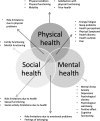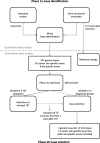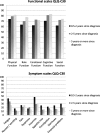Understanding the quality of life (QOL) issues in survivors of cancer: towards the development of an EORTC QOL cancer survivorship questionnaire
- PMID: 29866185
- PMCID: PMC5987570
- DOI: 10.1186/s12955-018-0920-0
Understanding the quality of life (QOL) issues in survivors of cancer: towards the development of an EORTC QOL cancer survivorship questionnaire
Abstract
Backround: The number of cancer survivors is growing steadily and increasingly, clinical trials are being designed to include long-term follow-up to assess not only survival, but also late effects and health-related quality of life (HRQOL). Therefore it is is essential to develop patient-reported outcome measures (PROMs) that capture the full range of issues relevant to disease-free cancer survivors. The objectives of this project are: 1) to develop a European Organisation for Research and Treatment of Cancer (EORTC) questionnaire that captures the full range of physical, mental and social HRQOL issues relevant to disease-free cancer survivors; and 2) to determine at which minimal time since completion of treatment the questionnaire should be used.
Methods: We reviewed 134 publications on cancer survivorship and interviewed 117 disease-free cancer survivors with 11 different types of cancer across 14 countries in Europe to generate an exhaustive, provisional list of HRQOL issues relevant to cancer survivors. The resulting issue list, the EORTC core questionnaire (QLQ-C30), and site-specific questionnaire modules were completed by a second group of 458 survivors.
Results: We identified 116 generic survivorship issues. These issues covered body image, cognitive functioning, health behaviors, negative and positive outlook, health distress, mental health, fatigue, sleep problems, physical functioning, pain, several physical symptoms, social functioning, and sexual problems. Patients rated most of the acute symptoms of cancer and its treatment (e.g. nausea) as no longer relevant approximately one year after completion of treatment.
Conclusions: Compared to existing cancer survivorship questionnaires, our findings underscore the relevance of assessing issues related to chronic physical side effects of treatment such as neuropathy and joint pain. We will further develop a core survivorship questionnaire and three site-specific modules for disease-free adult cancer survivors who are at least one year post-treatment.
Keywords: Cancer survivor; Disease-free; Health- related quality of life; Oncology; Survivorship questionnaire.
Conflict of interest statement
Ethics approval and consent to participate
The study was approved by the METC-AVL (P16SUR) and has been performed in accordance with the ethical standards as laid down in the 1964 Declaration of Helsinki and its later amendments or comparable ethical standards. Informed consent was obtained from all individual participants included in the study.
Competing interests
The authors declare that they have no competing interests.
Publisher’s Note
Springer Nature remains neutral with regard to jurisdictional claims in published maps and institutional affiliations.
Figures





References
-
- Aaronson NK, Ahmedzai S, Bergman B, Bullinger M, Cull A, Duez NJ, Filiberti A, Flechtner H, Fleishman SB, De Haes JC. The European Organization for Research and Treatment of Cancer QLQ-C30: a quality-of-life instrument for use in international clinical trials in oncology. J Natl Cancer Inst. 1993;85:365–376. doi: 10.1093/jnci/85.5.365. - DOI - PubMed
MeSH terms
Grants and funding
LinkOut - more resources
Full Text Sources
Other Literature Sources
Medical

